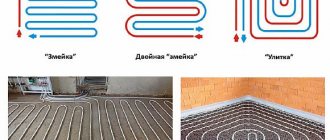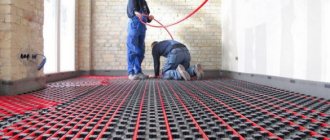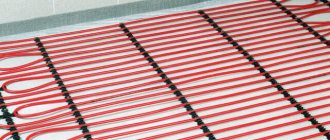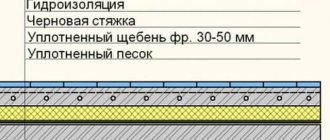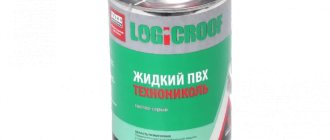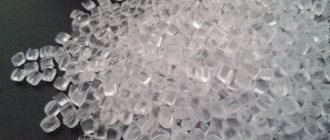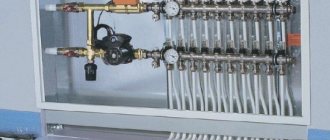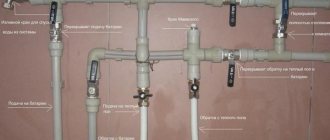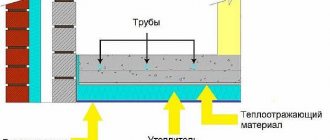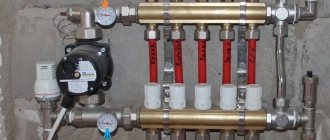Why is a thermal insulation substrate required?
If the heated floor is installed according to all the rules, then its efficiency allows the system to be used as the main heating, although not for all rooms and not in all climatic zones. A poor-quality substrate for a warm water floor reduces the heating efficiency so much that it can only be used as an additional one.
Diagram - layers of heated floors
The diagram shows the substrate under the pipes
The presence of a high-quality substrate can reduce unproductive heat losses by 20% or more. This element is especially important on the first floors - thermal energy goes into the ground. On the second and higher floors, the lost heat at least warms the lower rooms, but this is little consolation.
The substrate is necessary for heat conservation
Energy is more evenly distributed across the floor area. There are no areas too cold or too hot. The negative impact of high temperatures on finishing flooring and furniture is minimized.
Without a backing, heat is distributed unevenly
Financial losses are significantly reduced not only for floor heating in winter, but also for its installation and maintenance. A substrate with bosses allows you to try several options for laying pipes, while temporarily fixing their position may not be necessary. Installers have the opportunity to choose the most convenient places to connect the system and install sensors for monitoring operating modes in optimal places. Due to this, control of the water heating system becomes more reliable and accurate.
The support with bosses makes the pipe laying process easier
The thermal insulation substrate, in addition to its main tasks, serves as an effective sound insulator. This is a very important factor for old-built apartment buildings; they have very low heat saving rates, losses can be 40–50%. Another additional function of some types of substrates is vapor and waterproofing.
The substrate is a good insulator
Installation of the substrate
The underlay for the laminate, regardless of its type, must be laid on a clean and flat surface (concrete or wood). When installing it on a heated water floor, you need to lay out a plastic film as waterproofing, and then lay the material on it.
It is placed at the joint, there should be no overlap. The principle of the arrangement of the slabs resembles brickwork, that is, there is a slight offset.
The need for a distance from the walls is individual for each material; there is a manufacturer’s note about this on the packaging. This mainly applies to cork and pine flooring. The canvases are connected to each other using tape. After which, the finishing coating (laminate) can be installed on it.
When laying embossed material, its smooth side should be facing up. If you use cork or pine pad, then you need to lay them perpendicular to the direction of the laminate boards.
Before installing the plug, the surface should be treated with an antifungal compound. When installing rolled material, it must be allowed to rest for some time after spreading.
Laying laminate flooring on a warm floor. Making the right substrate.
The process of constructing a heated floor with a laminate underlay is simple and does not require any experience. The main thing is to follow the installation technology correctly.
As you can see, the lining under the laminate on a warm structure is an important and obligatory layer of the “pie”. It’s up to you to decide which underlay to choose for underfloor heating under laminate. However, you should take into account the characteristics of the room and the warm structure, as well as the characteristics of the laminate, and then you will achieve the optimal microclimate in the room.
What parameters should you use to select substrates?
Today, manufacturing companies offer a wide range of underlays for warm water floors. This, on the one hand, helps to make the optimal choice, but on the other hand, complicates it. Only knowing the main requirements for substrates can you consciously decide on a substrate that is acceptable for a particular water floor option.
Elasticity, compressive strength. A water heating system is quite heavy, especially when expensive copper pipes are used. The substrate should not sag, and the thickness of the heat-insulating layer should not decrease. In addition, if the load is removed, the material must return to its original state.
The substrate must be durable
Resistance to negative factors during operation. The more stable the characteristics of the substrate are at different temperatures, the higher the quality of the material.
Low thermal conductivity coefficient. One of the main indicators. Moreover, it is desirable that the substrate at the same time have a small thickness. The underfloor heating system already reduces the height of the room; if the heat insulator is also thicker, then the decrease in height becomes very noticeable.
The backing should not be too thick
Resistant to prolonged direct contact with water. During the operation of heated floors, emergency situations caused by leaks may occur. Despite the fact that the installation technology provides for a whole range of measures to ensure reliable waterproofing of the load-bearing base, one more obstacle to water will not hurt. Another important indicator is the percentage of maximum water absorption. The substrate should not absorb water, and if this is the case, then the structure of the material should ensure rapid drying. It is desirable that it dry without the need for complete dismantling only under the influence of natural ventilation.
The photo shows an emergency leak of a heated floor
Price. Today there is a large selection of special substrates available, and the price range is impressive. Experienced users should be able to select products with the optimal quality-to-cost ratio.
mat for heated floor
Versatility. The substrates can be assembled according to the design principle, which allows installers to change the length and configuration of the pipeline system contours during the installation of water heating.
Substrates and mats should be universal and easy to install
Let's look at several types of the most commonly used underlays for warm water floors.
Does it work or not?
The foil underfloor heating is the most controversial. There are two opposing opinions. One is for using this material. Its supporters claim that there will be significant savings on losses “to the floor” due to the reflection of heat back.
Even most of the diagrams are drawn using foil under the heated floor heating element
Second opinion - you need thermal insulation, put 50 mm EPS. Foil or 2 mm backing with a shiny floor will not help with this. And reflection in a solid body does not work, so it makes no sense to talk about reflected heat in the thickness of concrete. Let's take a closer look at both points of view, and then look at the test results.
How can foil in a screed help?
As you know, radiation can be reflected from shiny surfaces. The heat in the screed is also partially transferred by radiation. By turning back at least some of the downward rays, you can reduce heat loss. This is what the foil underlay for heated floors is designed for. It is placed on the base, and on top are pipes with coolant. That part of the thermal radiation that is directed downward will be reflected and returned to the room. In theory, losses should decrease.
Reflective insulation: is it suitable for underfloor heating?
This is exactly what sellers of foil materials say. Many people decide that the costs are not too high, and a possible reduction in the payment for coolants warms the soul. Moreover, the screeds (the preparation and the actual screed with the heated floor) still need to be “untied.” So you can use not just plastic film, but foamed polyethylene with lavsan coating or foil.
When installing a film heater, a substrate must be laid underneath it. As a backing, you can use foil material or any other type of thin elastic material (technical cork, pine backing, etc.). Film heated floors are most often made under laminate, and it has a drum effect. The main task of the substrate is to level out micro-irregularities in the base and reduce the drumming effect. Foamed polyethylene copes with this task well. And the foil film helps retain heat. These are again the sellers' arguments. Sounds tempting.
Arguments of opponents
Let's discuss the second opinion, which is that foil, foil backing or any other shiny material in a screed cannot work. For now we are talking about the possibilities of reflecting radiant heat. Yes, shiny surfaces reflect radiation (light and heat, in particular). But for this, in front of the reflective layer there must be a layer of material transparent to this radiation. So, when insulating walls/ceilings, an air gap of several centimeters is left between the foil layer and the finishing. In this case, no questions arise about its effectiveness. There is no mention of a gap in the screed. Or rather, not quite like that.
Before installing the heating element, a foil backing for the heated floor is laid
Theoretically, such a gap exists if a layer of foil or other protective material is filled with a transparent polymer. This was done to protect the foil from destruction in the concrete layer. Simply, the gap size must be no less than the length of the reflected wave. And it is a fraction of a millimeter. So, in theory, the protective layer of polymer is sufficient to meet the reflective conditions. But is it possible to say that reflected rays can significantly affect the overall heat loss...
In the thickness of concrete, heat exchange by radiation constitutes a very small proportion. There is no specific data, but this is not even 1%, but less. However, we will assume that one percent of the heat is transferred by radiation. Let half be directed downwards (in reality less). This is 0.5%. Not everything that is directed downward will be reflected either. Let it be half too. Total, this is 0.25%. That is, no more than 0.25% of heat can be returned. With underfloor heating costs of 5,000 thousand, the savings will be 12.5 rubles per month. Not funny.
Foil insulation is not uncommon. But does it make sense to put it on a warm floor?
Plus, the most popular (because the cheapest) material in this category is polyethylene foam with a shiny coating. It is suitable for insulating walls and ceilings. And in a screed or under a laminate, under load it wrinkles. There is no trace left of the “foaming”. All that remains is a thin layer of polyethylene and a film on top. So it cannot work as insulation in a screed. In general, it is difficult to say whether reflective insulation works in a heated floor design.
What do experiments show?
All disputes and statements are just theories and attempts to apply existing knowledge to an unexplored area. No one has yet carried out a “pure” experiment that would clearly prove whether foil works or not in a heated floor design. There are a couple of experiments carried out by “ordinary users” who wanted to find out for themselves the feasibility of using a foil backing for a heated floor.
First experiment
The first testing was carried out with a heating film on which the laminate was laid. One part uses Folgoizol 2 mm thick with foil and a protective coating, the other uses foamed polyethylene of similar thickness, but without lamination. Readings were taken using a pyrometer. As usual, in such devices the temperature is displayed in color. The darker the orange, the warmer it is. This model also had the ability to display results in the form of a table. Data in the photo.
Results of measuring the temperature of a heated floor with and without foil
According to these data, it turns out that there is a difference in the temperature of the floor with the same insulation with and without foil. It is 1.5°C. Not much, but quite noticeable. Just like with our hand, we feel the difference between the forehead of a healthy person (36.6) and a sick person (38). Approximately the same difference will be felt by the legs.
Checking the work in the screed
The second experiment was carried out by simulating a water heated floor. Three pieces of screed 35 mm thick were poured onto a concrete hollow slab. One area was without insulation, the second was using Folgoizol. This is 2 mm polyethylene foam with a foil coating. The third is with foamed polyethylene 5 mm thick. A coolant pipe is passed through all three ties. To level out the temperature difference, the speed of movement was chosen to be high, which minimized the difference.
Foil element for a warm water floor: works or not
If you look at the graphs, it turns out that the temperature of the screed with foil is 1.5 degrees higher than without it. That is, this experiment shows approximately the same difference as the previous one, but under different conditions.
conclusions
Based on these two different experiments, it turns out that practice shows: foil underfloor heating works. It’s not clear why, but the reflective layer makes a difference of about 1.5°C, which is pretty good.
To be fair, it must be said that the experiments are not entirely “clean”; there are flaws in the organization. But there are no similar refutations. Believe them or not is your business. Whether to use a foil underlay for a heated floor or not is also your choice. There are no final conclusions either in favor or in denial. So you make the decision yourself.
This definitely works where there is an air gap
The only thing that is known for sure is that aluminum foil is not poured into the screed. It turns into dust in a couple of months. But foil or its spraying is more effective than lavsan spraying (also shiny). And to prevent the foil from corroding, it is protected with a layer of polymer. So if you decide to use a foil underlay for a heated floor, choose one with foil and a protective film on top of it.
So what to do?
Heat loss when heating the floor can be reduced by using insulation of appropriate thickness (50-70 mm optimal). And two millimeters of foil insulation (even if the reflection works) will not affect the picture too much. Even if you take a centimeter foil insulation. Under the weight of the screed, it is compressed into a couple of millimeters of hard polymer with fairly good thermal conductivity. So it will not be able to significantly reduce heat loss.
What is the secret of foil materials
Don't want to warm the planet or your neighbors below? Place full-fledged normal insulation under the screed with heated floors. EPPS performs best. It needs 50-70 mm. Does the idea of reflected heat and savings due to this warm you up? Attach foil to the EPS and cover with film. The effect will be the same.
Do you need a foil backing for a film heated floor? According to the technology, it is necessary to lay a substrate under the heating film that will compensate for micro-irregularities. Ideally, a technical cork, but foamed polyethylene will also work. If you don't really need to reduce heat loss, it's not bad.
Expanded polystyrene boards
Polystyrene heated floor
The lightest (by weight) installation system for water heated floors today
The plates are made using the extrusion method; this technology makes it possible to obtain materials of increased density and physical strength. It has closed cells, which has a positive effect on water resistance; the boards do not absorb moisture and are not afraid of prolonged direct contact with water. The initial parameters do not change when heated to t°=+130°C.
Expanded polystyrene boards for water heated floors
Mats for heated floors made of expanded polystyrene foam
For heated floors, sheets up to 3 cm thick are used. Expanded polystyrene is easily cut with a mounting knife, and the amount of waste during installation is insignificant.
Application of polystyrene foam boards for water heated floors
The joints in the seams are sealed with polyurethane foam or sealed with tape. To improve heat conservation, the surface can be covered with aluminum foil. They are used mainly in new buildings; the height of the heated floor must be taken into account during the development of design documentation for the building. In terms of price they are in the middle category.
Screed - finishing coating for a warm water floor
Expanded polystyrene board
Basic materials for underlayment for heated floors
And again we return to polystyrene foam. Why is this material most often used? What are its main features during application?
Traditionally, a warm water floor in most cases looks like this. A polystyrene foam substrate is mounted on the rough base, which is covered on top with a Mylar vapor barrier film and metal plates. Often, instead of plates, foil film is used. The main role played by metal plates or foil is maximum and uniform transfer of thermal energy to the floor surface from the heating pipeline.
The distinctive features of extruded (foamed) polystyrene foam include one of the lowest thermal conductivity coefficients. According to this parameter, judging by the data in the table, expanded polystyrene is second only to mineral wool.
This material does not allow heat to escape into the subfloor, and by interacting with the metal layer, ideal conditions are created for the uniform distribution of heat over the entire surface of the floor with maximum efficiency. The floor screed, laid on top of the entire structure, becomes a solid heating element with a large heating surface area.
Important! Expanded polystyrene can withstand heating temperatures up to 900C, so pipes can be laid directly on the substrate without fear of harming the insulating material.
Usually, in practice, they work with expanded polystyrene, the density of which is 25-35 kg/m3. Thick foam is used in the underlayment of floors on the first floors, which are located directly above the foundation or above the basement rooms. Here a sheet or plate 100 mm thick is taken. If there are no slabs of the required thickness, foam plastic is laid in two layers (50mm + 50mm).
For interpanel floors, when installing warm water floors in a city apartment, polystyrene foam with a thickness of 20-30 mm is used.
Other materials used when equipping the substrate are:
- foil materials;
- cork covering;
- mineral wool;
- mineral mats;
- Fiberboard;
- penofol.
The choice of one material or another is determined by the condition of the base on which the water loop will be installed in the future and the type of floor covering. A water heated floor that provides heating of the interior space in a separate room must have a substrate capable of performing two functions:
- high reflectivity;
- prevent moisture from penetrating into the subfloor in emergency situations.
It is appropriate to say that recently profile mats, which are universal materials, are being used more and more often. The products have a thermal insulation layer and bosses, with the help of which it is convenient to quickly and accurately lay the loops of water circuits.
However, in this case there are also disadvantages. The waterproofing properties of a substrate made from profile mats leave much to be desired. Therefore, in such a situation it is necessary to lay an additional waterproofing layer.
Important! During the installation process, it is worth remembering that the foil layer must extend onto the walls in order to compensate for the thermal expansion of the screed.
Markings are applied to the substrate, according to which the water pipe is laid. Here it is necessary to take into account the pipe laying step, which for heated floors should not exceed 30 cm.
Cork backing
A material of universal use, one of the most successful options for insulating floors with water heating systems.
Cork insulation for heated floors
Environmentally friendly material, made from cork tree bark. The raw materials are pre-crushed, and special binding components are added to the mass. The mass is pressed and dried on production lines. Finished products are sold in sheets or rolls. The cork substrate has high thermal protection and can withstand significant loads. To improve performance, the front surface is covered with foil.
Cork backing
Cork backing
Thermal conductivity of subfloors
There are a huge number of different types of flooring, ranging from ceramic tiles to wood. They all have certain characteristics, including heat conductivity.
Before we get acquainted with the thermal conductivity of floor coverings, let's find out what thermal conductivity even is? In other words, it is the ability of bodies or materials to transfer heat.
Heat conductivity indicators:
- tiles – 1.05 W per m2;
- linoleum - 0.2 W per m2;
- parquet board – 0.15 W per m2;
- carpet - 0.12 W per m2;
- cork 0.034 W per m2.
The lower the thermal conductivity, the longer the coating retains heat. Based on these indicators, we can say that the material that retains heat the longest is cork. The tile also has this function, but it heats up quickly.
In order for floor heating to be as productive as possible, the floor covering for the heated floor must conduct heat well and quickly. Here, ceramic tiles come first, although they require more powerful heating.
Properties of a quality substrate:
- high rates of waterproofing and thermal insulation;
- high reflectivity;
- resistance to temperature changes;
- vapor barrier;
- soundproofing;
- resistance to damage;
- environmental Safety;
- installation available.
The underlay is considered a universal material, so it is used not only when installing a heated floor, but when laying parquet or regular laminate.
Polypropylene boards
One of the optimal options for thermal insulation of water heating, it is not afraid of elevated temperatures and humidity, and is the cheapest material in terms of cost. It is not afraid of aggressive chemical compounds and does not emit harmful substances during heating. It has low flammability and does not support open combustion. The reproduction of various microorganisms, including mold, is inhibited on the surface. It is approved for use by sanitary control organizations without restrictions. The slabs may have ready-made grooves for laying pipelines.
Polypropylene boards
Sheet polypropylene
OSB or chipboard boards
They have been used for a relatively long time and allow the installation of heating pipes of increased diameter. They have high levels of mechanical strength and are of the average level in terms of heat-saving characteristics. A prerequisite is that the slabs must be moisture resistant. The P5 chipboard substrate can withstand cement screed.
Warm water floor in a prefabricated dry floor screed
OSB board
Metallized film based on natural lavsan
Modern material, used for all types of heated floors. Does not tear, withstands great breaking forces. Can be used on uneven surfaces - speeds up and simplifies the process of installing underfloor heating with water heating. Does not burn, retains original factory characteristics for a long time. Disadvantage: it is afraid of water and needs reliable and functional water protection.
Metallized lavsan film
foil backing
Rules for installing substrates
It is recommended to install the elements on the most even surfaces; you should not rely too much on manufacturers’ advertising statements about high strength that allows installation on uneven surfaces. If the substrates are made of materials containing wood, then waterproofing must be done. Except in cases where water-heated floors are installed on wooden floors.
Installation of a polystyrene system using mounting mats
The presence of aluminum foil is an important advantage. It not only significantly improves heat saving performance, but also serves as another waterproof barrier. Special substrates not only improve the quality and efficiency of heating systems, but also significantly reduce the installation time. You should not save on their purchase; taking into account all factors, the money invested will not only pay off, but will also bring considerable direct profit.
Warm floor: installation stages
Characteristics of materials for substrate equipment
In some cases, homeowners try to use any materials that are on hand or that are low cost for thermal insulation.
Let's consider the characteristics of a substrate made of various materials:
- Polyethylene foil, self-adhesive - thickness 8 mm. It is highly reflective, hydro and sound insulating.
- Single-sided polyethylene, laminated - thickness 8 mm. It has good thermal insulation and water resistance.
- Foamed polyethylene (Tepofol) - only 2 mm thick. Average thermal insulation parameters;
- Foil polystyrene of various thicknesses, with applied markings. High thermal insulation, hydro and sound insulating characteristics;
- Tuplex type substrate, branded product 3 mm thick. Has maximum parameters of heat, hydro and sound insulation;
- The base is made of polystyrene foam and lavsan coating, 3 mm thick.
The thinner the thermal insulation, the lower the thickness of the entire layer cake. Accordingly, the height of the flows in the room decreases slightly. The thickness of the screed over a water heated floor can vary between 50-60 mm.
The listed materials are the set that is presented in the retail chain today. The cost of materials may vary. Here, the amount of material used in the work and the intensity with which the floor heating should be carried out are taken into account.
Less commonly used is cork, which is made from crushed oak bark. There is one important aspect here - such material is environmentally friendly. However, if moisture gets in, it can become a place for fungus to develop. This material is supplied in rolls.
The cheapest option is foil polyethylene. Of all the listed materials, foiled polyethylene is the most common today. Despite the fact that the material is characterized by a high degree of thermal insulation and fairly moderate waterproofing, foil polyethylene does not have sufficient rigidity and strength.
In order to achieve quality when installing heated floors, try to use foil polystyrene. You should not pay attention to the cost of the material, it is high, but the obvious advantages will more than compensate for your costs, making the water floor durable and effective.
